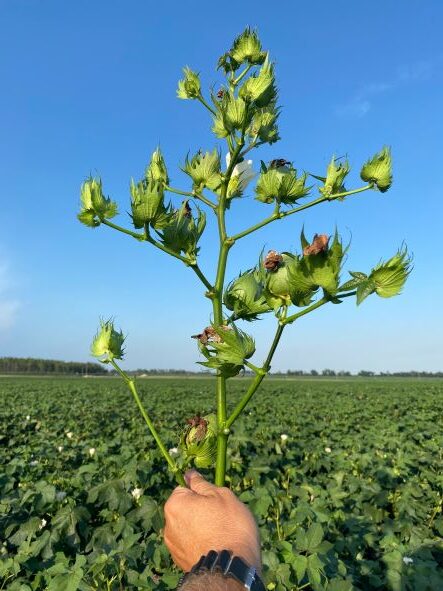Crop Scan Ag Report: Finishing Out the Crop
Cotton’s looking good in the Southeast and Mid-South as the crop pushes to finish out the top crop, while Texas remains a mixed bag with an early crop across part of the state and growers doing their best on the Plains to get what they can. Here’s what the Crop Scan consultants told us in late August.
Chad Harrell owns and operates Harrell Agronomic Services in Northeastern North Carolina.
Our cotton has progressed a lot since the last update. The April and early May planted cotton is starting to cut out and becoming safe from insects, although we need some rain to finish out those top bolls.
Many areas are starting to get dry as we have missed those spotty rains during the last couple of weeks. The early cotton has lost much of its top crop in these dry areas. Cotton planted toward the end of May is now at the fourth week of bloom and seems to be holding on to its fruit a little better. This cotton will need to be protected from lygus and stinkbugs for a couple more weeks.
Overall, our cotton looks good except for a few dry areas. I expect to see some decent yields this year if we can avoid any hardlock next month. In the absence of a hurricane, we should see all of our planted acres make it to harvest this year.
Wes Briggs consults on cotton, corn, peanuts, soybeans, and small grains for growers in Georgia, Alabama, and Florida.
Cotton continues to look very good. We’ve caught rain across all acres. Irrigated cotton is heavily fruited up, and dryland cotton is not bad. We still need a couple more rains to finish out our dryland acres.
This is one of our better cotton crops in the last 10 years. We’ve had good cotton the past several years, but late rains in August and September rotted 300-400 pounds. We all remember October 10, 2018, when Hurricane Michael devastated my area, taking the entire cotton crop. If we could pick today with good weather, this cotton crop may be one of the best in 35+ years.
Good boll load in South Georgia (Photo: Wes Briggs)
Despite all increases in cost production and challenges thus far, we are sitting on a very good crop. Our oldest cotton is still 30-40 days off on defoliation. We also have a lot of young cotton ranging from first bloom to fifth week bloom that still requires protecting from plant bugs, stinkbugs, and whiteflies. Mid-August thru mid-September is all about managing water, boll rot, disease, PGR, and these late season pests.
As of today, yield potential looks very good. Cotton is pointed in the right direction. We need sunshine and less rain over the next 30 days to capture these bottom bolls. It’s been a long summer. Hopefully, we can finish strong.
Tucker Miller is a Mississippi-based independent private consultant for cotton, soybeans, corn, peanuts, rice, and vegetables.
Most all our cotton is finishing up and blooming out. We made our last insect sprays on the later cotton this week. Irrigation has been terminated on all acres. We do not need any more rain on this crop.
Open bolls in Mississippi (Photo: Tucker Miller)
Our crop is potentially one of the best I have looked at in a long time. The cotton fruited really well and made all the way to the top. There won’t be any switches in the top this year. The Bollgard 3 trait worked well this year, and our plant bug pressure was about normal, much less than last year. This allowed us to make a good top crop, which is hard to do with heavy lygus pressure late season.
We are looking at starting some defoliation on our early cotton in about 10 days. I hope everyone has a good harvest season with blue skies and white cotton fields.
Mark Nemec is an independent agricultural consultant for cotton, wheat, grain sorghum and corn in the Blacklands and Brazos River Bottom area of Central Texas.
The cotton crop in Central Texas is wrapping up fast. Harvest aids have been going out on dryland acres for the last week or so. Some early fields have already been harvested. We are two to three weeks earlier than normal this year with all the heat and lack of rain. Of course, our weather pattern has changed and now we are getting rain showers slowing down the harvest. Yields have been lower than normal as well.
It looks like about 10-20% of the dryland acres are going to be abandoned in my area – mostly late planted or replanted cotton that didn’t have a good root system before the oven was turned on. Irrigated fields are starting to pop open and will be defoliated soon. Growers here are hoping to get this year behind us and look forward to next year.
Kerry Siders is Texas A&M AgriLife Extension Agent-IPM for Hockley, Cochran, and Lamb Counties.
Here on the Southern High Plains of Texas, cotton ranges from plants which suffered drought conditions and never flowered to good drip irrigated cotton which have cracked-open bolls. That is an extreme range, but a real reflection of how this season has gone for us.
I would estimate that we have maybe 1% rainfed cotton acres that could possibly be harvested. Rainfed acres account for half of all our acres. Our irrigated acres are down to about 40% of what was planted, and not all of that will be harvested.
We have many fallow acres which we rarely see, and those acres are generally bare ground. As we have an increased chance of rain this late summer, I know many producers have a goal to plant a cover crop on this fallow land to keep it tied down hopefully until next planting season.
Cotton is generally safe from most insect pests other than keeping watch on a few plant bugs until the end of August. Irrigation continues in some fields which have a yield potential to justify the expense. A concern about the potential for late rains is we have a light boll load in many remaining fields which may be encouraged to develop regrowth. This late growth will only detract from what yield and quality has already been established.
September will allow us to evaluate yield a bit better and determine how we approach harvest. Many producers have the idea now that they will let a freeze condition the cotton for harvest. However, knowing that this crop will most likely go through the boll maturation process long before we receive a killing freeze suggests that significant deterioration of lint could occur. Therefore, a budget must still allow for harvest aid expenses.

















